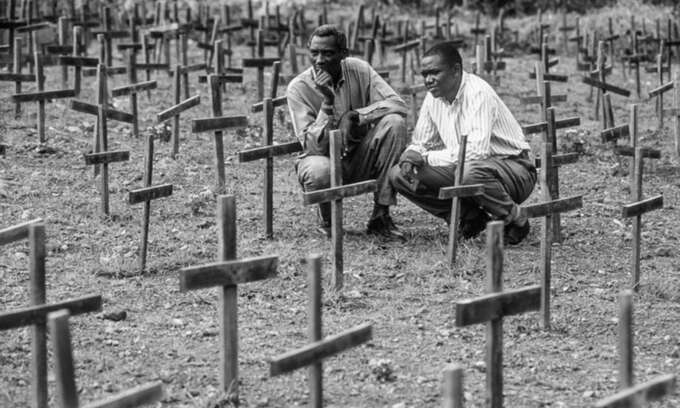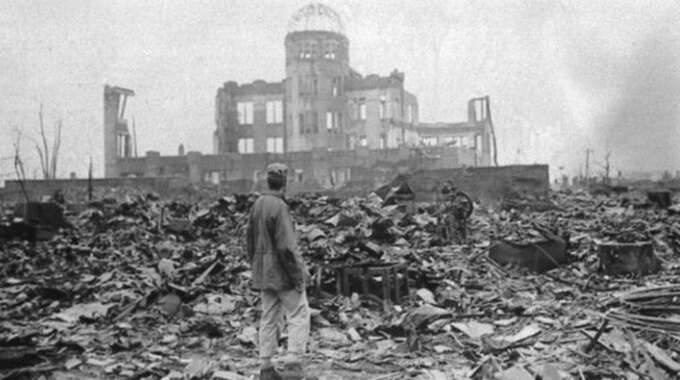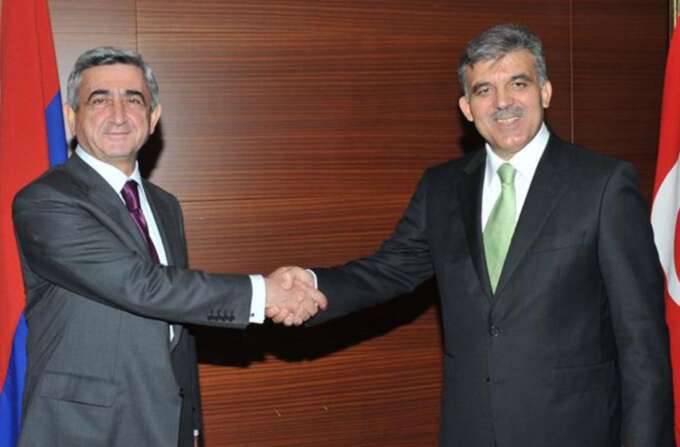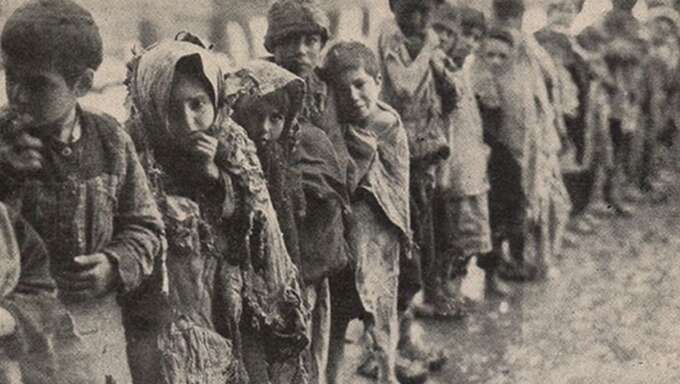Life after deaths: How nations reconcile following bloody conflicts
With a “peace summit” set to take place in Switzerland later this June, speculation is again rampant regarding the potential for ending Russia’s ongoing invasion of Ukraine via some form of diplomatic solution.
Such discussions largely focus on the conditions for ending the conflict, but there is little discourse on what is likely to follow the end of kinetic hostilities. Experience shows that post-conflict settlement is a complex and painful process that can span many decades. The Insider looks at past examples — those of Rwanda, Armenia and Turkey, and Japan and the United States — in order to explore what might be in store for Russia and Ukraine once the fight on the battlefield finally ends.
End of the war
The first step towards reconciliation is always the cessation of physical fighting. However, this rarely happens quickly or easily.
The genocide in Rwanda was stopped only after the Tutsi army, which had been gathering strength outside the country for several years, returned home and crushed the Hutus with military force. This was followed by trials for those accused of responsibility for the genocide. Some of these trials ended in execution, but even three decades later, some are still ongoing. In any case, reconciliation could not begin until the country came under new leadership.

Two Tutsis at the site of a village where all the inhabitants were killed
For Armenia and Turkey, the issue of the World War I era genocide has not been settled, but has simply shifted into a new phase. Persistent disagreements over the recognition of the Armenian genocide and conflicting views on the Nagorno-Karabakh conflict have led to failed negotiations. Following the collapse of the USSR in 1991, Turkey recognized Armenia’s independence, but diplomatic relations have remained severed since 1993. However, in the fall of 2022, the leaders of both countries held talks for the first time. Passenger and cargo air traffic was restored, and negotiations to open the land border are ongoing.
Japan, having lost World War II, was occupied by U.S.forces from 1945 to 1952. The Americans conducted trials of war criminals, disbanded the Japanese armed forces, and carried out a series of large-scale military, political, economic, and social reforms.
Recognition of guilt
A logical step after the end of any conflict would seem to be the aggressor’s recognition of their guilt. However, this does not always occur. Sometimes, rather than apologies, the injured party is met with new accusations.
At the International Criminal Tribunal for Rwanda, Jean Kambanda, who served as Prime Minister during the entire 100 days of the genocide, admitted his responsibility for what had transpired. This marked the first time in history that a head of government was convicted of genocide and acknowledged his guilt in an international criminal tribunal. Kambanda is now serving a life sentence in Mali.
Armenia, like dozens of other countries, regards Turkey’s treatment of Armenians from 1915-1917 as genocidal, but it has yet to receive an apology from Turkey — this despite the fact that the Ottoman authorities in charge during the period in question were overthrown in 1922. Today, official Ankara rejects the accusation that its predecessors in Constantinople carried out genocide against the Armenians. Instead, Turkey accuses Armenia of exhibiting bias, exaggerating the losses, and outright lying, all while claiming that “logic and evidence refute the claims of genocide.”
Japan has traveled a long path from military aggression to repentance. It officially acknowledged guilt for its actions during World War II for the first time in 1995, on the 50th anniversary of its surrender. However, 20 years later, then-Prime Minister Shinzo Abe narrowed the circle of those he believed should be held accountable, asserting that people who did not participate in the conflict should not bear responsibility for it. Abe stated that, “We must not allow our children, grandchildren, and future generations to be condemned to apologize.”
Armenia, like dozens of other countries, regards Turkey’s treatment of Armenians from 1915-1917 as genocidal, but it has yet to receive an apology from Turkey
As for the U.S., formal apologies for the atomic bombings of Hiroshima and Nagasaki — let alone for the firebombing of Tokyo — have never been issued. In 2016, then Secretary of State John Kerry became the highest-ranking American official to visit Hiroshima and lay flowers at the memorial to the victims of the first atomic bomb. However, there was no discussion of admitting guilt. A member of the delegation at the time stated that Japan was not seeking apologies from Kerry, as both countries “aimed to demonstrate the strong ties established since the end of World War II and their mutual commitment to global peace.”
In 2023, President Joe Biden also visited the Hiroshima Peace Memorial Museum during the G7 summit in Japan. He, too, did not apologize for the nuclear bombings. As explained by National Security Advisor Jake Sullivan, the president did not make a statement in Hiroshima because, from his point of view, “this is not a bilateral event.”
Legislative initiatives
One way to establish relations following the cessation of armed hostilities is to adopt special laws that essentially impose a new logic of state governance on the former aggressor — instilling “friendship” and common values in former enemies.
Creating a new citizen
In Rwanda in 1999, five years after the end of the genocide, the National Unity and Reconciliation Commission was established. The authorities launched several programs.
- Ingando (or solidarity camps) is an educational program aimed at studying the history of Rwanda, understanding the roots of divisions within the population, fostering patriotism, and combating the ideology of genocide.
- Itorero aims at the development of society, strengthening the value system of Rwanda, and nurturing active members of society. Both Ingando and Itorero involve physical exercise, military training, cultural programs, and political education.
- Umuganda is a monthly event in which residents gather to perform some form of work. Every able-bodied Rwandan aged 18 to 65 must participate. Those who refuse risk fines or even arrest.
Most initiatives aim to build a unified social community and bring people together through training, recreation, or labor. The authorities hope to create a “new citizen of Rwanda” with a specific set of values, views, and knowledge. To this end, the government has invested significant resources in “civic education.”
Adopting reforms and a constitution from the winning side
Japan also underwent significant changes at the legislative level after the war. However, it did not implement these changes of its own free will. The post-war “restructuring” of the country can be divided into three stages: punishment and reform, economic revival, and the signing of a peace treaty and alliance with the U.S.

Hiroshima one month after the explosion
AP
During the initial phase, the occupying Americans conducted trials of war criminals. The Japanese military was dissolved, and officers were prohibited from assuming leadership roles in the new government. Land reform was also implemented. Additionally, efforts were made to transition the Japanese economy towards a capitalist system, as the occupying authorities grew concerned that communist sentiments might gain traction in Japan due to its fragile post-war economic state.
The United States also paid attention to Japanese domestic law. In 1947, the country adopted a pacifist constitution — one drafted by American legal experts. Under this constitution, the nation permanently renounced war “as a sovereign right of the nation and the threat or use of armed force as a means of settling international disputes.” The document explicitly declared that Japan would refrain from ever again establishing land, sea, and air forces or any other instruments of war.
Even after the occupation formally ended, American forces remained in Japan indefinitely thanks to the adoption of the United States - Japanese Security Treaty, which was signed in 1951 and updated in 1960. In 1954, the country was permitted to reconstitute a limited military, known as the Japan Self-Defense Forces.
Joint government-level international events
Following the conclusion of a conflict or during a period of calm, countries occasionally take tentative steps towards reconciliation at the official level. This may not always signify a definitive path towards friendly relations, but it certainly sends positive signals that interaction between the states are beginning to progress in the right direction.
Funerals and football unite
For instance, Levon Ter-Petrosyan, the first president of Armenia, made just such efforts to mend relations with Ankara. In April 1993, shortly after Turkey had closed its border with Armenia following Yerevan’s capture of Azerbaijan’s Kalbajar district, Ter-Petrosyan attended the funeral of Turkish President Turgut Ozal. According to Tigran Grigoryan, the head of the Regional Center for Democracy and Security in Yerevan, this gesture held significant symbolic importance at the time:
“Those years were particularly challenging from a humanitarian standpoint, and there was an arrangement for grain to be imported to Armenia through Turkey. These processes continued until the borders were completely sealed.”
Still, despite official announcements in March 2023 that the countries had agreed to open the border to third parties, it remains closed.

Serzh Sargsyan and Abdullah Gul
Over the last three decades, the nations have undertaken numerous efforts to establish diplomatic ties and reopen the border. One of the most successful endeavors, known as “football diplomacy,” occurred in the late 2000s.
In 2008, Turkish President Abdullah Gul attended a football match between Turkey and Armenia in Yerevan at the invitation of his Armenian counterpart Serzh Sargsyan, the first such visit in the history of the two countries. The following year, Sargsyan made a reciprocal trip to attend a match between the two national teams in Bursa.
The Turkish side was prepared to address the conflict, and agreements were even signed, including some pertaining to the establishment of diplomatic relations and the reopening of the border. However, these agreements were not ratified by the Turkish parliament, and Armenia also declined to do so. The primary obstacle was Azerbaijan, which argued that “normalizing relations between Turkey and Armenia before the withdrawal of Armenian troops from the occupied Azerbaijani territories directly conflicts with Azerbaijan’s interests and undermines the spirit of fraternal relations between Azerbaijan and Turkey.”
Another attempt to improve relations was made after the end of the Second Karabakh War in 2020. Armenian officials visited Turkey. Following a devastating earthquake in Feb. 2023, Armenian trucks carrying humanitarian aid entered Turkey for the first time in thirty years. The next month, Armenian Prime Minister Nikol Pashinyan attended Recep Erdogan’s inauguration (even if the Turkish leader did not mention his Armenian counterpart among those officially present at the event). In addition, the countries appointed special representatives for normalizing relations.
However, these were all merely symbolic gestures, and reconciliation is not yet on the agenda. The processes of normalizing relations between Armenia, Turkey, and Azerbaijan are closely intertwined. Without advancements in relations between Armenia and Azerbaijan, significant progress on the Armenian-Turkish front is unlikely. Former Turkish Foreign Minister Mevlut Cavusoglu reiterated this sentiment in 2021, stating that Ankara would coordinate all measures to normalize Armenian-Turkish relations with Baku.
People-to-people ties
Despite the chilly relations between countries on a governmental level, connections among people and cultural and social organizations can be remarkably amicable.
One such warming of relations was noted between Turkey and Armenia. According to the UN, a turning point in the relationship between Yerevan and Ankara occurred during a scientific conference in Istanbul in 2005, which led to the publication of several scholarly works on Armenian heritage in Turkey. A significant catalyst for this shift in rhetoric was the 2007 assassination in Istanbul of Hrant Dink, a Turkish-Armenian journalist and an outspoken advocate of reconciliation between the two countries.

Children waiting in the snow for the opportunity to enter the “City of Orphans”
This tragedy spurred a portion of Turkish society to reassess its past, fostered more open public dialogues, and precipitated a shift in the tone of public discourse. Notably, in 2008, Turkish intellectuals orchestrated a campaign in which nearly 3,000 individuals signed a petition expressing apologies to Armenians for the “Great Catastrophe.”
In 2009, the Hrant Dink Foundation in Turkey initiated a journalist exchange program between Turkey and Armenia to enhance coverage of events in the neighboring states. Subsequently, the foundation expanded its efforts to develop other initiatives aimed at fostering bilateral relations. In parallel, Yerevan launched initiatives focused on acknowledging and highlighting the contributions of “good” Turks who safeguarded the lives of Armenians.
Initiatives to bring the countries closer at the societal level continued even after some deterioration in relations between officials. In early 2014, with the participation of the European Union, an association of NGOs from Turkey and Armenia launched the Armenia-Turkey Normalization Process Support program.
Within its framework, the countries organized exchanges and educational trips for journalists, creative professionals, and environmentalists. They set up summer schools for teachers, and also set up exhibitions, fostered scientific discussions, and supported the Turkish-Armenian youth orchestra.
Fruits of reconciliation
Despite the efforts of some post-conflict countries towards reconciliation, the outcome is not always favorable. Even in successful cases, no healing of ties is accomplished without some setbacks along the way. And there are instances in which, despite official amity, the population of one state may harbor mistrust towards another for decades after the actual fighting has ended.
One step forward and five steps back
Therefore, despite the collaborative efforts undertaken by Armenia and Turkey at both the governmental and societal levels, their relationship has recently regressed yet again. In 2020, Turkey’s involvement in military actions alongside Azerbaijan — in contrast to its more neutral stance during the First Karabakh War of the early 1990s — inevitably impacted its relations with Armenia.
In 2022, the two nations resumed air traffic, but in May 2023, Turkey temporarily closed its airspace to Armenian carriers in response to the unveiling of a monument in Yerevan dedicated to individuals involved in operations against Ottoman officials, whom Armenia holds responsible for the Armenian genocide.
Simultaneously, Turkey requires positive relations with Armenia to enhance its reputation among Western allies, particularly the United States
It is difficult to assess how ready the societies in both countries are for the normalization process, says the Armenian political analyst and activist Grigoryan. “If you look at the polls conducted in Armenia after the Second Karabakh War, Turkey seems to occupy the first place in the list of external threats and opponents. Most Armenians perceive Turkey in this context.”
Simultaneously, experts believe that Turkey requires positive relations with Armenia in order to enhance its reputation among Western partners, particularly the U.S. In addition, relieving the tensions with Yerevan could help enable Turkey to reestablish a “policy of good neighborliness” with its closest nations, reminiscent of the first decade of Erdogan’s leadership.
Dissatisfaction with dependence
The case of Japan demonstrates that accommodations can be reached so long as both sides are willing to compromise. Almost immediately after the end of the American occupation in 1952, Japanese officials began looking for a way to revise their externally-imposed constitution, particularly Article 9, which mandates Japan’s permanent renunciation of war and the military. However, over time, this article has simply been subject to more liberal interpretations. As early as 1954, Japan was able to establish its self-defense forces, and in 1992, a law was adopted permitting these troops to participate in peacekeeping missions. In 2015, Japan’s upper house of parliament authorized the use of self-defense forces beyond Japan’s borders and in scenarios of “collective self-defense“ to safeguard friendly nations. Notably, criticism of the decision did not focus on the all but nonexistent fear of Japanese imperialist expansion, but on the concern that Tokyo might become entangled in U.S. military operations abroad.
In December 2022, Japan unveiled a plan for its most extensive military buildup since World War II, purchasing missiles capable of striking China. This made Japan the third-largest military spender in the world behind only the U.S. and China. Simultaneously, Japan opted to enhance security cooperation with Australia, the UK, the Philippines, and India, suggesting a potential desire to decrease its reliance on American protection.
In 2015, the Pew Research Center sought to evaluate the diverse mutual perceptions of American and Japanese citizens at the societal level. Americans frequently express positive sentiments about the Japanese, describing them as “hardworking,” “resourceful,” and “trustworthy.” Over 90% of American respondents associate the term “hardworking” with Japanese people. However, Japanese attitudes were less positive: they characterize Americans as “resourceful” and “assertive,” but only 37% of respondents associate the term “trustworthy” with Americans.
Overall, Americans’ attitudes towards Japanese are better than Japanese attitudes towards Americans
Ban on discrimination and dissent
Rwanda appears to have successfully overcome any lingering hostility within its borders, even if experts note that the government’s intolerance of dissent presents challenges in accurately assessing societal sentiments. In fact, the authorities in Rwanda have enforced reconciliation among its population, outlawing ethnic discrimination and subjecting debate on the matter to potential criminal prosecution.

A Tutsi boy in front of a mass grave where all his relatives are buried
Presently, Rwanda stands as one of the safest countries in Africa. However, reflecting on its history, the authorities prioritize the role of the armed forces in achieving both internal and external stability, emphasizing the significance of a robust military for Rwanda, and for the continent as a whole.
Read more similar news:
Comments:
comments powered by Disqus


































